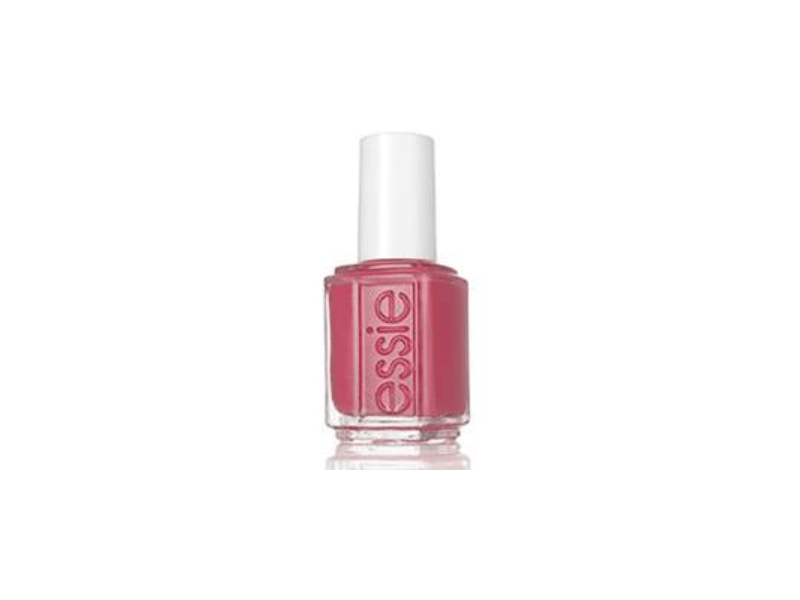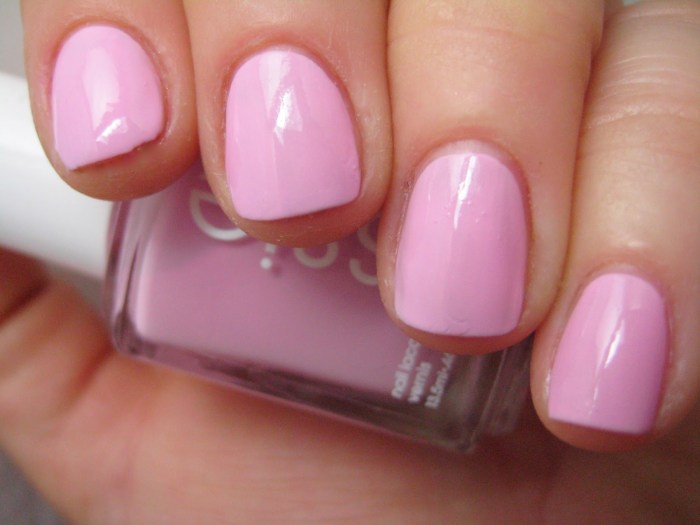Essie Nail Polish Ingredients A Deep Dive
Essie Nail Polish Ingredients: A Comprehensive Overview
Essie nail polish ingredients – Essie nail polish, a renowned brand in the beauty industry, boasts a wide array of colors and finishes. Understanding the ingredients used in their formulations is crucial for consumers concerned about safety, environmental impact, and product performance. This overview delves into the composition of Essie nail polishes, examining their individual components, regulatory compliance, health and environmental effects, and future trends.
Common Ingredients in Essie Nail Polishes
A variety of ingredients contribute to the unique properties of Essie nail polishes. The following table compares common ingredients across different color ranges, highlighting their functions, benefits, and potential risks.
| Ingredient | Function | Potential Benefits | Potential Risks |
|---|---|---|---|
| Nitrocellulose | Film-forming agent | Provides durability and shine | Potential irritant for sensitive individuals |
| Butyl Acetate | Solvent | Enhances flow and application | Volatile organic compound (VOC), potential respiratory irritant |
| Ethyl Acetate | Solvent | Improves leveling and drying time | Volatile organic compound (VOC), potential respiratory irritant |
| Tosylamide/Epoxy Resin | Adhesion promoter | Increases adhesion to the nail | Potential skin irritant |
| Titanium Dioxide | Pigment | Provides opacity and whiteness | May cause irritation in some individuals |
Chemical Structures of Key Ingredients

Source: skinsafeproducts.com
Five key ingredients commonly found in Essie nail polishes and their chemical structures are detailed below. Note that providing the actual chemical structures in text format is complex and would require specialized chemical notation software. The following descriptions offer a simplified overview.
1. Nitrocellulose: A polymer composed of cellulose nitrate, characterized by its long chain structure and ability to form a strong, flexible film upon drying.
2. Butyl Acetate: A colorless liquid ester with a characteristic fruity odor, known for its solvent properties.
3.
Ethyl Acetate: Another colorless liquid ester, similar in properties to butyl acetate but with faster evaporation.
4. Tosylamide/Epoxy Resin: A complex resin system that enhances the adhesion of the polish to the nail surface.
5. Titanium Dioxide: A white pigment composed of titanium and oxygen atoms arranged in a crystalline structure.
It is known for its high refractive index and opacity.
Sourcing and Manufacturing Processes
Essie’s sourcing and manufacturing processes prioritize quality and consistency. The company sources its raw materials from reputable suppliers who adhere to strict quality control standards. The manufacturing process involves precise blending and mixing of ingredients to achieve the desired color, texture, and durability. Specific details regarding supplier names and precise manufacturing locations are typically considered proprietary information.
Regulatory Compliance of Essie Nail Polish Ingredients
Essie nail polishes comply with international and regional safety standards, including those set by the FDA (in the US) and the EU’s REACH regulation. These regulations dictate permissible levels of certain ingredients and require comprehensive safety testing before products can be marketed.
Comparison with Competing Brands
A direct comparison of Essie’s ingredient lists with those of three competing brands (e.g., OPI, Sally Hansen, Zoya) would reveal similarities and differences in formulations. While some common ingredients (like nitrocellulose and various solvents) are likely to be present across brands, the specific types and proportions may vary, leading to differences in performance characteristics, such as drying time, durability, and shine.
Access to precise ingredient lists for all brands would be needed to conduct a thorough comparison.
Regulatory Approval Process for New Ingredients
A flowchart illustrating the regulatory approval process for a new Essie nail polish ingredient would depict a series of steps, including initial safety assessments, toxicology studies, formulation development, and submission of data to relevant regulatory bodies. The process is rigorous and ensures the safety of the new ingredient before it is incorporated into a commercial product. The precise steps and timeline vary depending on the regulatory body involved.
Potential Health Effects of Prolonged Exposure
Prolonged exposure to certain Essie nail polish ingredients, particularly solvents like butyl acetate and ethyl acetate, can lead to respiratory irritation, headaches, and dizziness. Some individuals may experience allergic reactions or skin irritations from certain pigments or resins. Proper ventilation during application and avoidance of prolonged direct skin contact are recommended.
Environmental Impact of Manufacturing and Disposal
The environmental impact of Essie nail polish production encompasses several factors. The manufacturing process consumes energy and resources, and the disposal of packaging materials contributes to waste. The use of volatile organic compounds (VOCs) in the formulations also raises environmental concerns. Essie’s efforts to minimize these impacts are discussed in the following section.
Sustainable Practices Employed by Essie
- Use of recycled materials in packaging.
- Reduction of VOC emissions in formulations.
- Investment in sustainable sourcing of raw materials.
- Support for responsible waste management practices.
Role of Resins and Polymers in Nail Polish Properties

Source: staticflickr.com
Different types of resins and polymers play a crucial role in determining the texture, shine, and durability of Essie nail polish. For example, nitrocellulose contributes to film formation and shine, while other polymers may enhance flexibility or adhesion. The precise combination of resins and polymers used is proprietary to Essie.
Performance Characteristics of Different Pigment Types
The performance characteristics of Essie nail polish vary depending on the type of pigment used. Different pigments offer varying levels of opacity, color intensity, and brilliance. For instance, pearl pigments create a shimmering effect, while metallic pigments provide a reflective finish. The choice of pigment significantly influences the overall appearance and visual appeal of the final product.
Properties and Applications of Solvents and Thinners
| Solvent | Properties | Application in Nail Polish | Environmental Impact |
|---|---|---|---|
| Butyl Acetate | Colorless liquid, fruity odor, good solvent | Dissolves resins and improves flow | Volatile organic compound (VOC) |
| Ethyl Acetate | Colorless liquid, fruity odor, fast evaporating | Improves leveling and drying time | Volatile organic compound (VOC) |
| Isopropyl Alcohol | Colorless liquid, fast evaporating | Used as a thinner and cleaning agent | Relatively low environmental impact compared to other solvents |
Common Allergens in Essie Nail Polish, Essie nail polish ingredients
Common allergens found in Essie nail polish include certain resins, pigments, and fragrances. Individuals with sensitive skin or nails may experience allergic reactions such as redness, itching, or swelling. Essie’s commitment to minimizing these risks is detailed below.
Minimizing the Risk of Allergic Reactions
Essie employs various methods to minimize the risk of allergic reactions, including careful selection of ingredients, rigorous testing, and clear labeling of potential allergens. The company continuously researches and develops new formulations to reduce the potential for sensitivity.
Labeling Requirements for Allergens
Essie nail polishes adhere to labeling requirements for allergens and other potentially harmful ingredients, as mandated by relevant regulatory bodies. These labels clearly list the ingredients and provide warnings as needed to inform consumers about potential risks.
Essie nail polish, known for its wide range of colors, often features ingredients like nitrocellulose and plasticizers. However, removing these polishes requires a gentle yet effective solution, and for a safer alternative, consider using a remover like the ella mila nail polish remover , which is known for its gentler formula. Understanding Essie’s ingredients helps in choosing the right remover to maintain nail health.
Emerging Trends in Nail Polish Formulations
Emerging trends in nail polish formulations focus on incorporating natural or sustainably sourced ingredients, such as plant-based polymers and pigments. There’s a growing demand for “5-free” or “7-free” polishes, which exclude specific potentially harmful chemicals.
Essie’s Research and Development Efforts
Essie invests in research and development to improve the safety and performance of its products. This includes exploring new, safer ingredients and refining manufacturing processes to reduce environmental impact.
Evolution of Essie Nail Polish Ingredients
Over the past decade, Essie has gradually shifted towards formulations with fewer potentially harmful ingredients. This evolution reflects a growing awareness of consumer concerns regarding health and environmental sustainability. The company’s ingredient lists have seen a reduction in the use of certain solvents and the introduction of more environmentally friendly alternatives. A visual representation would show a timeline, with earlier formulations featuring a higher concentration of certain VOCs and a later shift toward more natural and sustainable options.
Clarifying Questions: Essie Nail Polish Ingredients
Are Essie nail polishes vegan?
Not all Essie nail polishes are vegan. Check individual product labels for specific ingredient information.
Are Essie nail polishes cruelty-free?
Essie is generally considered cruelty-free, meaning they do not test their products on animals. However, it’s advisable to check their official website for the most up-to-date policy.
How long do Essie nail polishes typically last?
The longevity of Essie nail polish depends on factors like application technique, base coat use, and individual activity levels. Generally, you can expect a chip-free manicure for about a week.
How can I remove Essie nail polish safely?
Use a gentle, acetone-free nail polish remover to minimize damage to your nails and surrounding skin. Always apply the remover to a cotton pad and gently hold it against the nail for a few seconds before wiping.
















